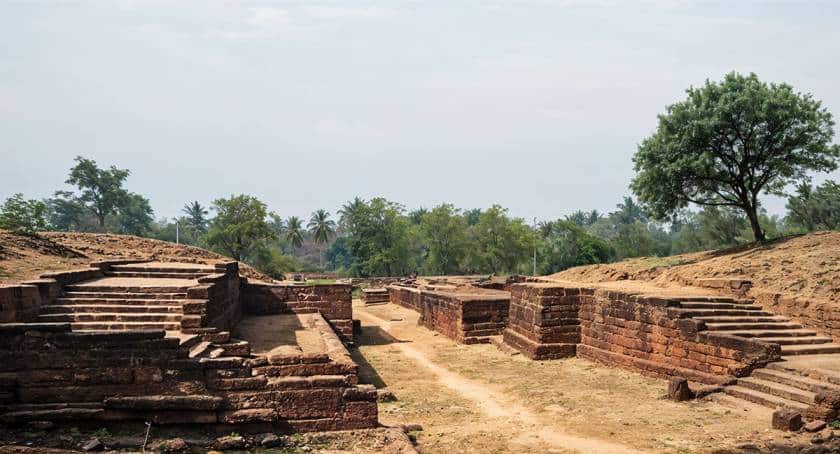The Mysterious Ruins of Sisupalgarh, Odisha
Situated in the heart of Odisha, India, lies an ancient site steeped in mystery and historical significance: the ruins of Sisupalgarh. Often overshadowed by the more famous Konark Sun Temple and Jagannath Temple in Puri, Sisupalgarh remains a hidden gem for history enthusiasts and archaeologists alike. This fortified city, dating back to the early centuries of the Common Era, offers an intriguing look into Odisha’s rich past and is an essential destination for anyone interested in the evolution of ancient Indian civilization.
Uncovering the History of Sisupalgarh
The Sisupalgarh ruins stand about 20 kilometers from Bhubaneswar, the capital of Odisha. Experts have identified the site as the remains of an ancient fortified city that once flourished in the Kalinga region. Although scholars disagree on the precise chronology of Sisupalgarh, most agree that it began in the third century BCE and continued into the fourth century CE. Historians believe this site was a significant urban settlement during the Mauryan and post-Mauryan periods, playing a key role in ancient Odisha’s cultural and economic life.
The Kalinga kingdom likely included Sisupalgarh, a region renowned for its historical significance, especially after the epic Kalinga War (circa 261 BCE), when the Mauryan emperor Ashoka famously fought against the Kalinga army. While Sisupalgarh’s precise connection to this war remains unclear, the site’s proximity to Bhubaneswar suggests it was an influential urban center during Ashoka’s reign and the Mauryan Empire’s expansion.
The Discovery of Sisupalgarh
The archaeological significance of Sisupalgarh began to be recognized in the 1940s, though serious excavations did not occur until the 1950s. Early excavations revealed several structures and artifacts that provided crucial insights into the nature of this ancient city. Further excavations by the Archaeological Survey of India (ASI) have uncovered large defensive walls, gateways, residential buildings, and public spaces, all of which suggest that Sisupalgarh was a thriving and strategically important city in its time.
Sisupalgarh’s historical importance grows from its status as one of the few ancient cities in India built with such elaborate fortifications. Its designers showcased advanced urban planning by creating a network of streets, drainage systems, and defensive walls, highlighting the sophistication of its inhabitants.
The Layout and Features of Sisupalgarh
The ruins of Sisupalgarh reveal a highly planned urban structure. The city was enclosed by massive defensive walls of large sandstone blocks, with several gates for entry and exit. These walls, some of which still stand today, are evidence of the city’s robust fortifications to withstand invasions or attacks.
The defensive walls of Sisupalgarh are complemented by a series of moats, further indicating the site’s strategic importance. The archaeological remains of these moats suggest that the city’s designers aimed to make it impregnable, incorporating layers of security and defense mechanisms to protect its inhabitants from external threats.
Archaeologists have uncovered the remnants of the city’s residential buildings, public structures, and streets. The planners divided the city into many sections, designating some areas for residences and others for marketplaces, temples, and public spaces. One of the most significant findings at Sisupalgarh is a large circular structure, which may have been a ceremonial or public gathering space. Its purpose remains a mystery, but its size and location suggest it is essential to the city’s social or religious life.
Researchers discovered several inscriptions in the region; however, few of them suggest that a highly developed civilization engaged in administration, trade, and religious activities. The finding of objects, including tools, beads, and ceramics, indicates that the city was a center for handicrafts and cross-cultural exchange.
Sisupalgarh’s Role in Ancient Odisha
Sisupalgarh holds immense historical importance. The city served as a key administrative and cultural center for the Kalinga region, significantly shaping ancient Indian history. The city’s proximity to the sea likely made it a thriving port, facilitating trade with other areas of India and foreign civilizations. Sisupalgarh may have been a melting pot of cultures, with influences from ancient Southeast Asia, the Mediterranean, and the Middle East.
Historians believe the fort city served as a center of religious activity, with temples and sacred spaces scattered throughout the site. The remains of religious structures suggest that the people of Sisupalgarh worshiped various deities, including Hindu gods and possibly local, indigenous spirits.
Sisupalgarh Today, A Historical and Archaeological Wonder
Today, the Sisupalgarh ruins are a testament to ancient India’s architectural prowess and advanced urban planning. The site remains relatively untouched and reveals the life of one of India’s ancient civilizations. While it may not be as well-known as other historical sites in India, it is gradually gaining recognition among historians, archaeologists, and travelers interested in exploring lesser-known gems.
Though weathered by time, the ruins offer visitors an opportunity to connect with the past and experience the grandeur of an ancient city. The site is a marvel of ancient urban design and a reminder of the region’s rich cultural and historical heritage.
Final Thoughts
The Mysterious Ruins of Sisupalgarh are silent witnesses to the ancient glory of Odisha. As an ancient fortified city, it offers valuable insights into the history, culture, and architectural advancements of early Indian civilization. For those interested in exploring India’s hidden treasures, Sisupalgarh is a must-visit site, offering an unforgettable journey through time. Whether you are a history enthusiast, an archaeologist, or someone searching for an off-the-beaten-path destination, Sisupalgarh’s ruins promise to transport you to an era long past yet still remarkably relevant today.


